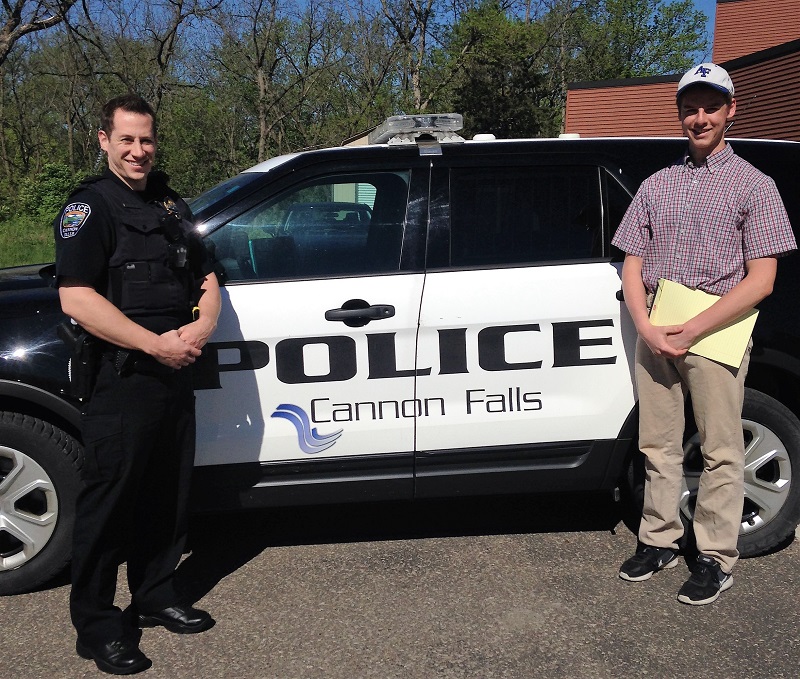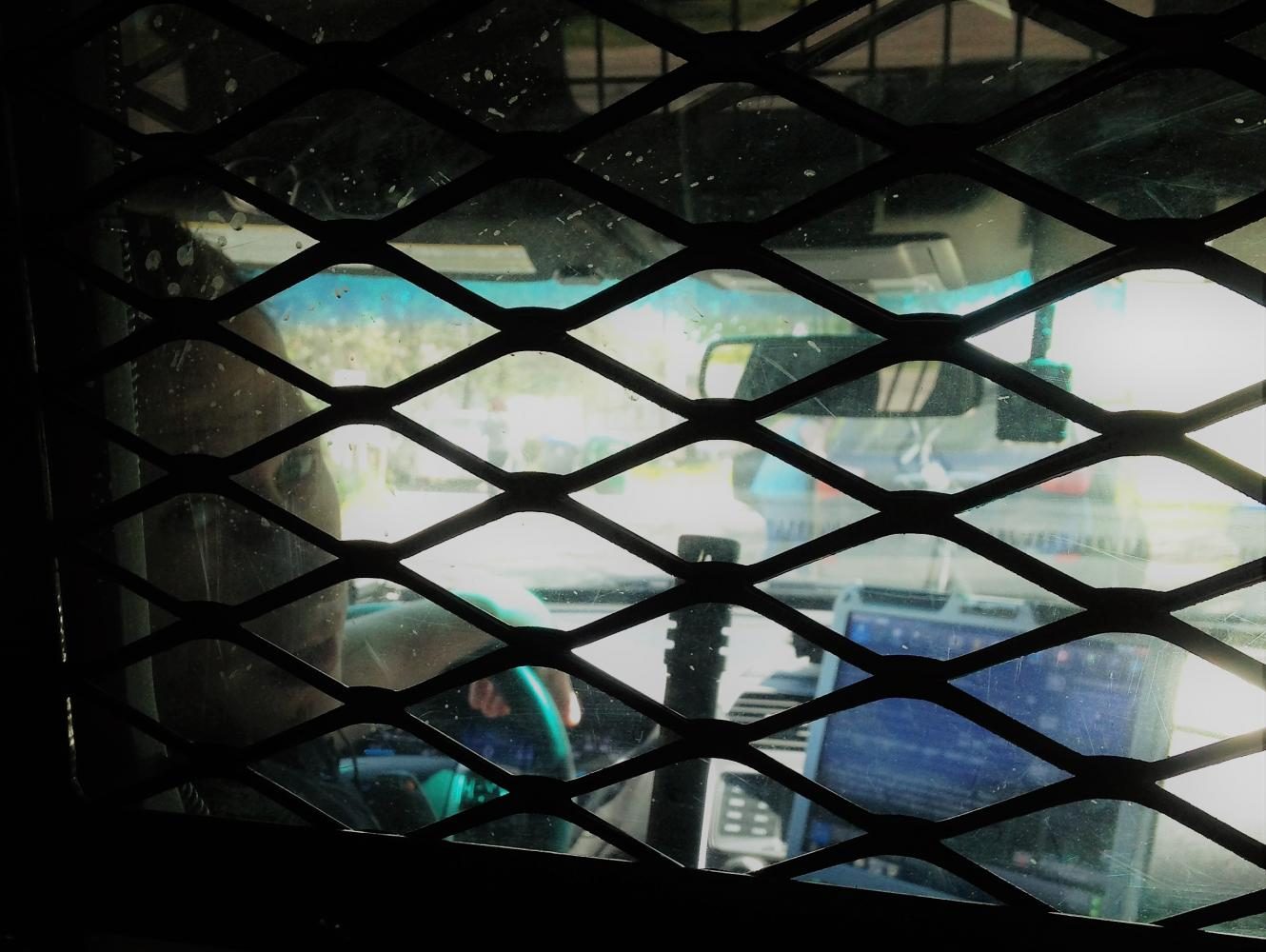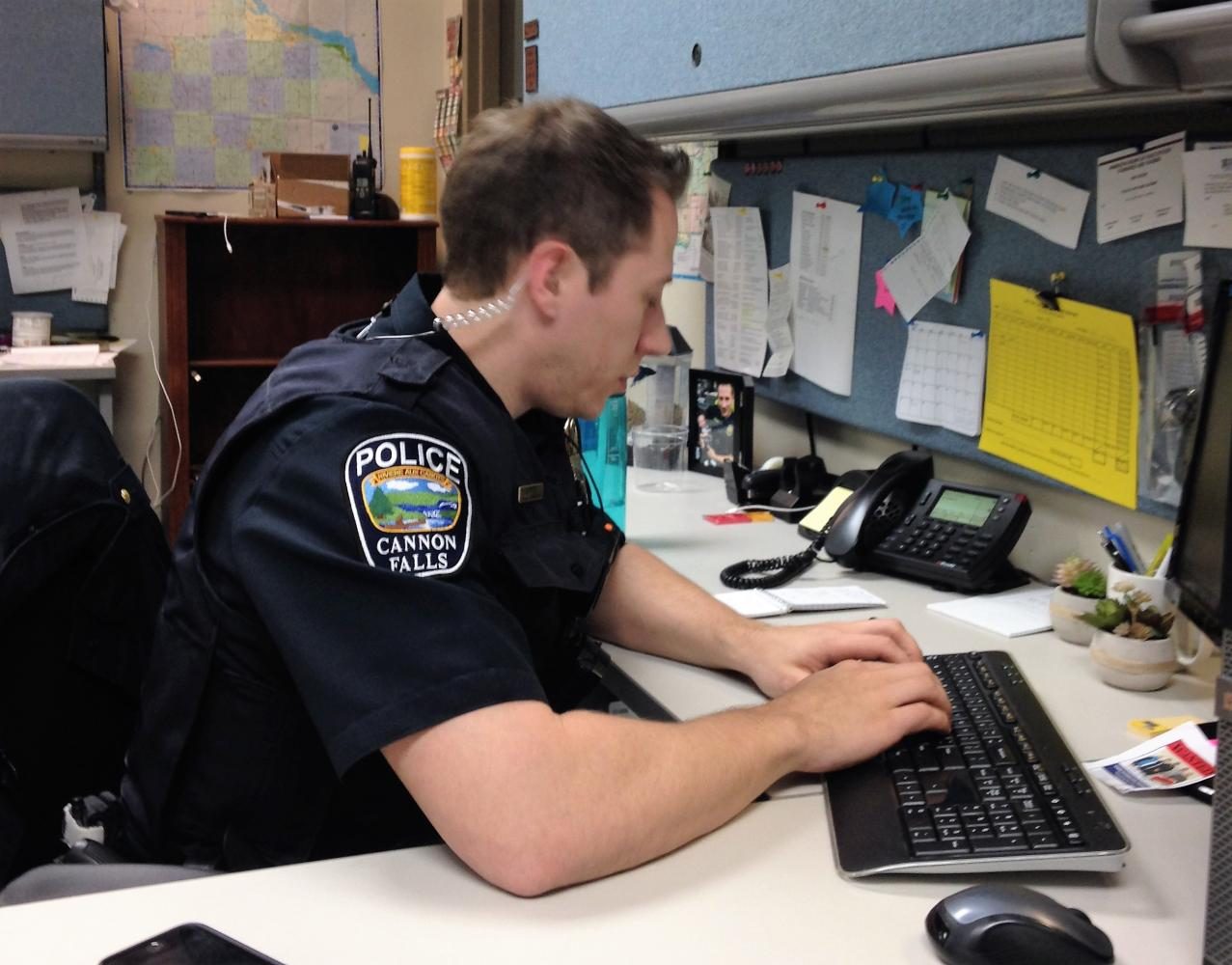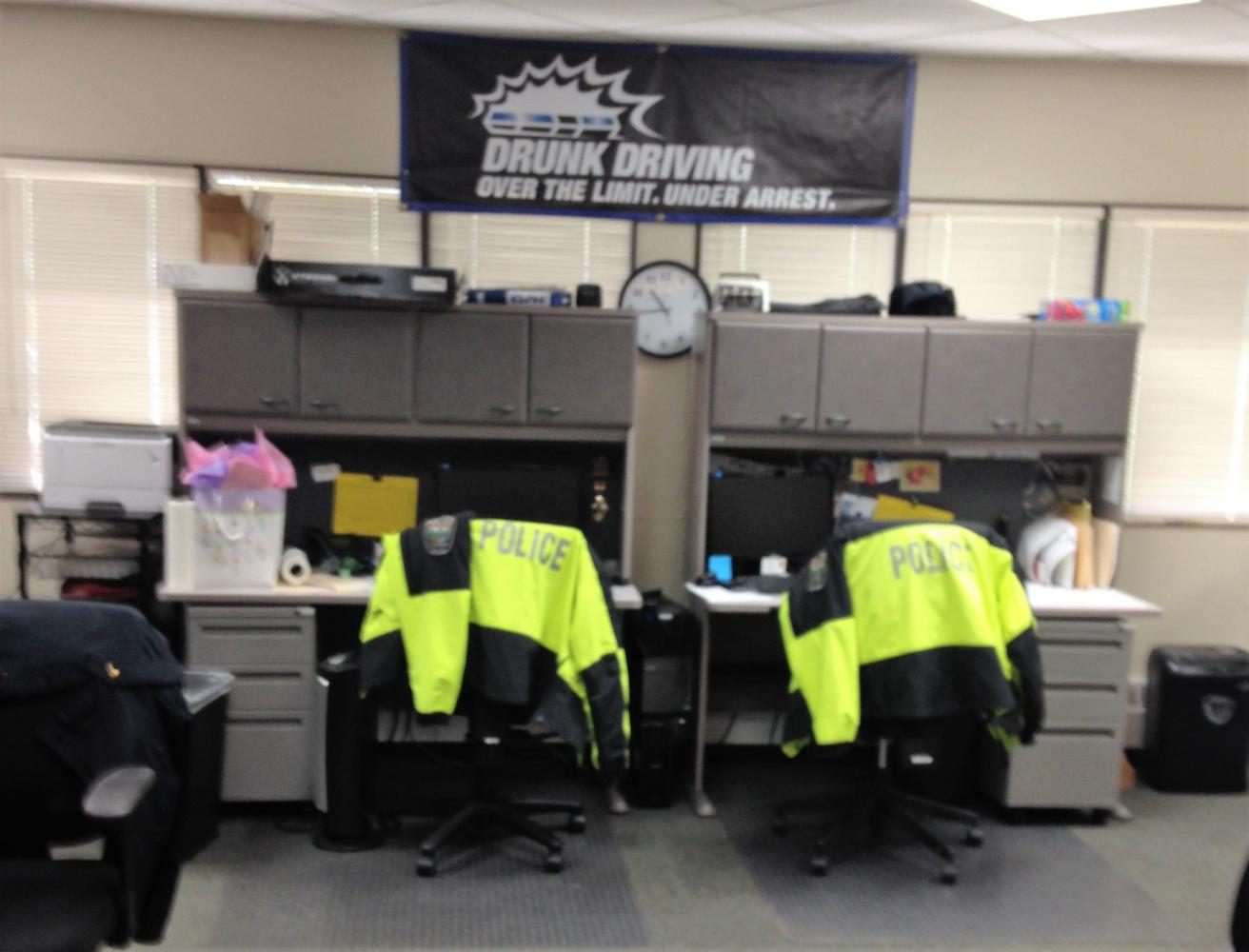Thin Blue Line
Lantern news editor Grant Schlichting rides along with local police officer to get some insight into the criminal justice system
May 30, 2017
It Begins
It’s eleven O’clock on a Saturday night and Officer Paul Larson has just pulled over a rusted green blazer that has a tail light out. As he steps out of the squad car he gets called by dispatch in nearby Red Wing. “Status?” “15” Meaning check in in 15 minutes. Like clockwork he pulls the flashlight from his belt full of gadgets and walks towards the car. He taps on the glass as a simple gesture to have the window rolled down, but nothing happens. As he shines his light through the window, he can make out a man reaching in the center console. At this point Larson puts his hand on his gun and thinks about Mendota Heights Officer Scott Patrick and the funeral flashes into his mind; a beaten Pontiac Grand Am was the last thing Officer Patrick saw before his life was taken from him. By the time the window rolls down, John Doe hands Officer Larson his driver license and registration. As the adrenaline slowly fades out of his system, Larson breathes a sigh of relief as he walks back to his car with the registration.
A ride-along
An added level of fear, stress, anxiety, grief, and adrenaline all make policing a difficult pill for a lot of people to swallow, yet men and women in blue all around the country wake up at 3 AM to cover an early morning shift or stay out until 1 AM doing late night patrols. I wanted to learn what makes these people tick. What makes officers get up in the morning not knowing what the day will hold? What makes them risk their lives to save those who would not even say thank-you in return? These questions brought me to the Cannon Falls Police Department. I signed up for a ride along and Officer Larson was open for one.
It was mere chance that I was able to ride along with an officer I already knew pretty well. I have a policy in my life of going up to anyone in uniform – whether it’s military or police – and saying thank you for your service. Larson stopped in one night during patrol to watch a high school basketball game, and my friend and I worked our way from the bleachers to tell him thanks for his service. What was going to be a five minute conversation turned into an hour, as we asked him questions about what life was like as a cop. As soon as I got into the squad car, we hit it off right where we ended two months ago at that basketball game.
Small town – big problems
Police Officers walk, drive and bike to protect our community without knowing what’s around the corner up ahead – Literally and figuratively. There may be more corners – and more troubles – in an inner city, loaded with gang violence and ethnic tension, but small town cops have their own array of problems that get overlooked by citizens across the country. A lot of danger lurks in the cornfields at night around small towns that are pit stops for the goods of commerce- and crime – that travels down the concrete arteries of our nations to the cities.
Small town like Cannon Falls can be extremely volatile. Highway 52 connects the town with metropoles like the Twin Cities, Rochester, and even Chicago. Locations right off of this main highway are ideal spots for drug dealers to transfer supplies from one vehicle to another or to meet buyers. As a sophomore I was coming home from a party and there was a drug bust right in the center of downtown Cannon Falls with at least twenty solid white blocks of cocaine. This is a problem that all offices have to face coming from small towns, because crime doesn’t just stop at a city’s borders.
Dealing with stress
A policeman’s struggle doesn’t stop once his shift ends. Trauma, PTSD, and fitting in with civilians all compound the problems an officer faces in the field. Research has shown that police have higher suicide rates than the general public. Dealing with the emotional problems that arise from having a tough job like policing has gotten better. Before in departments across America there was a ‘Tough Guy’ attitude that police officers shouldn’t seek out a psychiatrist or mental help. This mindset has changed and now almost every city has a counselor to deal with the traumatizing experiences that comes with the job. Officer Larson revealed one experience that was tough to handle. It was a snowy winter’s night, and he got a dispatch for a two year old girl “Acting Funny” when he arrived at the scene, she was not breathing and he started CPR. Once the paramedics arrived they brought her to the hospital, but she was later pronounced dead. Larson says “Law enforcement is realizing that for high stress, emotional encounters we have, we need to talk about it afterwards.” This is where the counselors come in, to help officers relieve some of the stress that comes with the profession.
Larson also affirms that having friends that aren’t police officers helps cops adjust back to civilian life and not dwell on the hardships of the job. But getting back to civilian life is just that – trying to get back to it. As the saying goes, crime never sleeps, so cops can’t either. For Officer Larson’s wife, Shelby, it can be tough. “It is definitely hard not having him around for holidays/big events.” She said. But the stress is there everyday when he goes to work, not just at Christmas dinner when there is an empty seat at the table. “The scariest part about being married to a cop is knowing after a shift, he may never come home. His life’s in danger every day.” These are the sacrifices patrolmen make – missing big holidays, moments with their children, and putting their life on the line – all in the name of duty, honor, and service to their community. It’s a sacrifice that cannot be overlooked.
It’s crucial for community-police relations that we understand what our men and women in blue face day in and day out. “Whenever someone tells me their dog won’t bite, I just don’t know,” affirmed Officer Larson. “I don’t know your dog, I need to take precautions.” These precautions may range from watching your dog, or if a car is pulled over late at night unbuckling his holster for a quick draw on his pistol. Citizens need to understand the situations police are placed in and that their lives are at stake everyday. With this information we must do everything in our power to help diffuse tense confrontations. My father told me that if I ever get pulled over, I should roll my window down, turn on the dome lights, and put my hands on the steering wheel. Simple gestures like this and staying calm while working with police will help prevent miscommunication, which in some instances has lead to violence.
Saving strangers
This was the first thing I noticed that helps people fill the role of being the guardians of our cities, institutions, and freedoms is the ability to create small talk. We weren’t even thirty minutes into the ride along when the sirens were flipped on and we were after a car that was going forty-six miles per hour in a thirty mile per hour zone. As we pull the lady over, Larson radios in the stop and then tells me, “Here is my mic volume control. Turn it up when I leave the car and you’ll hear everything I say.” As I turn up the volume he is already at the red sedan. As the window rolls down I hear him say “Hello ma’am how are you today?” He quickly gets to the point, and tells her about the speeding. After a while explaining to her where the thirty miles per hour law is enforce, he sees a toddler in the back without a booster chair. Once learning that she is four years old, he inquires why she doesn’t have a booster, and she explains that she was driving her daughter’s car. It also was just cleaned and she was in a hurry to get somewhere. As Larson says thank you and walks back to the car to get print off a citation, he decides to cut her some slack. With the citation in hand, he tells her that he’s going to give her a warning (Which is recorded in the online database so that other officers can be more strict once they see a warning has already been given) on the speeding but he is going to have to give her a citation for driving with a toddler not in a booster seat. He then reassures her that if she calls the number on the ticket and explains to them her predicament that they may be willing to write it off and she won’t have to pay as much. After she puts her hand on his arm and says “thank you for your kindness” Larson continues talking to her about where she can buy another booster if she wants and then talks a little bit about where she was going. After the chat was done, he sent her on her way and jumps back in the squad car. This empathy and caring wasn’t seen in just one situation, but over and over again as we continued on our ride along. We arrived with a sheriff’s deputy in the middle of the country when a 911 call was made out for a white van following a man walking down the road. Once we arrived we met up with the man, and talked about the situation. While we were waiting for other police to catch up with the van, Officer Larson started talking to the man (That he’s had to deal with once or twice before) about his life. He learned that he was going to soon go up to Brainerd and get a job painting houses. Even though he knows this man by name and all the problems he’s caused the county, he still talks with him like he’s an average citizen.
But many people don’t know this side of the police. When the Sheriff’s deputy walked up, I noticed how intimidating it could be to meet an officer. Larson and the Deputy both had their shades on, stood at least five feet eight inches tall, and Larson looked like he could catch a cheetah while the deputy could wrestle a gorilla. However beneath the oakley sunglasses are caring eyes for the community.
“It’s tough working a night shift when you haven’t met, let alone talked to anyone for four hours.” Larson said. This opportunity for talking is an integral part of what makes an officer tick. “One of my favorite parts of my job is the human interaction. Face to face, not in a cubicle or on a phone marketing.” After the situation was resolved, Larson started talking with the Deputy, and finally said he would have to make his way back to the ‘unlawful city’. After a quick laugh they say goodbye and head back to their cars. Two uniforms – the tan county and the dark blue city – both working together and caring for not only each other, but for the community. It was a reassuring moment and one that makes a heart content.
Never losing care
And its remarkable, arguably a miracle, that they don’t lose this caring attitude. “The saying goes we deal with five percent of the population that creates ninety-five percent of the problems,” affirmed Officer Larson. In Cannon Falls that means Officer Larson knows most of the trouble makers by name. Dealing with the same people over and over again in a small town would drive me crazy. “You have to keep your head level. If you get fed up with a case it will make you cynical.” After Larson said this, he told me a story about a man who was bouncing checks. Not just any checks, but a ninety year old’s check that he then claimed to be his own. He bounced checks in Cannon Falls, Red Wing, and even Prescott, Wisconsin. Once they finally caught the guy the District Attorney didn’t think there was enough to prosecute. While the legal system helps police get warrants and chase criminals, at time it can be a hurdle to justice.
Larson brought up an analogy of ticketing a woman $150. She continues her wrong doing, and he continues to ticket her. Finally he reaches the tenth ticket, and now she owes $1,500 to the state, However, if the judge chooses, he can nullify nine of them and tell her that she only has to pay one.. Cops go out everyday to protect the community, and the people they catch may never face jail time or get what they deserve.
“It’s just the way it is, and you can be mad about it that day, but you just can’t let it consume you.” Larson’s words of wisdom were right, for we live in a government like no other on the planet. We would rather inhibit our police than give them free reign on our information. We would rather have the oppressor run free then put the innocent behind bars. Everyone knew that the man was responsible for bouncing checks – but there wasn’t enough to persecute. She deserves much more punishment than just a $150 dollar fine, but there’s nothing that can be done once the judge reaches his verdict. The way cops look at it is in a saying, ‘They have to be perfect, we only have to be right once to catch them.” Indeed, time is on the side of the police, and in time justice will always prevail over evil and injustice.
The thin blue line
We were now halfway through our ride along, and after a morning of excitement it was time to head into the office and eat lunch. As we sit down, I look over to the top of his desk where on the wall a black, white, and gray American with a blue line in the middle was hung. I ask him what it is, and he says it’s the thin blue line, the symbol for fallen police officers and for those who support the boys in blue. As we’re eating lunch, I keep on looking at it and see much more meaning in it. Of the thirteen stripes, only one is blue. Only one decides to go out and deal with the darkness of the world. The biggest meaning I get out of it is that it’s a thin blue line – not only meaning there are only a few in the profession – but also that they have a very thin line to walk. Personal body cameras, the media ready to post any story of an officer screwing up and a ethnic divide all makes policing harder than it already is. “The media needs to learn that personal body camera’s are not a catch all,” Officer Larson stated. “With mine on my chest, if someone is on my left and pulls a gun on me, when I turn my hands are already up ready to defend myself and blocking the camera.”
But Larson agrees that these cameras are beneficial, and not only help keep officers in check but can help us understand what really went down in the situation. Since we were talking about keeping officers in check, I finally decided to ask him about the problems facing policing and the black community. It’s a question that’s plagued policing since the 50’s with Jim Crow Laws and water cannons, with dogs and riot gear. “I think both sides are at fault,” Larson said. He goes on to explain that new police need to learn how to deal with different cultures and ethnicities. “Other cultures have different behaviors than we do. Some will be more vocal, but that doesn’t mean that they’re going to hurt an officer. Others will avoid eye contact. In our culture that’s a sign of disrespect or that someone is hiding something, but in theirs that’s their way of showing respect.” This is the biggest thing to fixing the divide between policing – learning about one another. If only it was that simple.
Day’s end
All of a sudden we get a call from dispatch. Motorcycle accident on highway 52. My mind went numb. Whenever there’s an accident on 52 it isn’t good, and I thought back 9 years ago when my mother was T-boned on 52. It took her three months to recover. The sirens blare and the lights flash on and we get on the highway as fast as we can, traveling at nearly ninety miles per hour. We were the third vehicle at the scene. I jump out of the passenger seat, my boy scout instincts kicking in as I run towards the body, with paramedics and deputies circling the rider.
When we arrived I see a miracle had happened. I looked toward his bike, and it was just scratched. He wasn’t hit, just fell over by the wind and landed in the ditch. He still needed medical attention, but he could help get himself onto the gurney. Not even two minutes passed before the Cannon Falls Volunteer Fire Department arrived, and another five slipped away until the Minnesota Highway Patrol arrived.
After the man was loaded into the ambulance, I looked around at all the faces. Men and Women, all devoted to one cause. They come from ambulances, fire trucks, state, county, and city police vehicles, but they all share the same purpose. They all have one thing that unites them all. They help people. They choose to put their lives at stake – from running into burning houses, taking a 911 call into unknown territory, or sit on 52 while cars are flying by at 60 miles per hour all to help a stranger. It’s untarnished empathy. Unfettered compassion. It’s the closest thing to God’s love that I can think of on this green earth.
The day has come to an end. In the morning Larson had a drug bust. I joined him for a ride along and we did traffic stops, domestic assault problems, MRAAC Assault, county domestic dispute, business check, and finally a motorcycle crash on Highway 52. It was a lot to take in, but it was reassuring to know that we have a thin blue line – the few that answer the calling, the few that protect those who can’t protect themselves and the few that put their lives on the line so we can live in comfort. These are the officers that we know in Cannon Falls, and we can safely go to sleep knowing that we are protected by this thin blue line; always there, always ready, and always willing to help.








